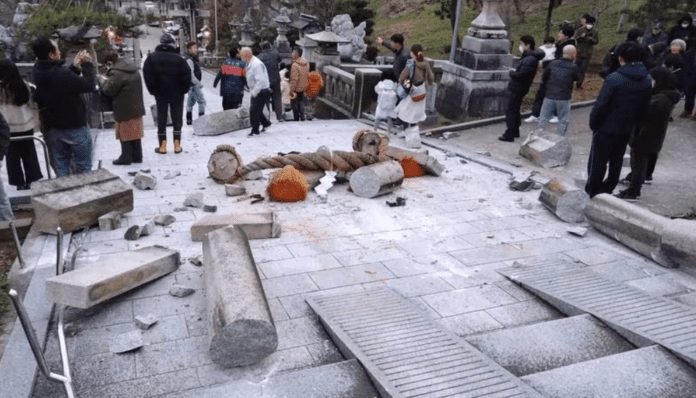In Japan, rescue workers are tirelessly searching for 242 people missing after the destructive earthquake that struck on New Year’s Day. The crucial 72-hour window to find survivors after the earthquake has ended, leaving the task even more challenging.
Following the 7.6 magnitude earthquake in the distant Noto Peninsula on Friday, the death toll has risen to 92. According to reports from Kyodo News Agency, Japan’s self-defense forces have doubled the number of soldiers participating in rescue and relief efforts to 4,600.
It is believed that many people are trapped under collapsed homes, particularly in the cities of Suju and Wajima, where structures were not designed to withstand frequent powerful earthquakes. A great number of people still lack access to water and electricity, and hundreds of people are stuck and in need of help due to landslides and blocked highways.
The moment when 7.6-magnitude earthquake hits Japan #earthquakejapan #Earthquake #japanearthquake2024 #Japan #Tsunami #JapanEarthquake pic.twitter.com/pe32jgGFTS
— WarMonitoreu (@WarMonitoreu) January 2, 2024
Japanese Prime Minister Fumio Kishida, after a meeting with disaster response officials on Friday, declared, “We will not give up.” He urged rescue and relief workers to reach affected communities without leaving any gaps.
The challenges faced by the Japanese Red Cross Society are enormous. Musubi Yata, a spokesperson, stated, “This is our biggest challenge. It is difficult to reach the devastated areas due to landslides on roads caused by rocks and rain, and subsequent aftershocks.”
Yata explained, “After the earthquake, we had to halt some medical activities because roads could collapse.”
According to Japan’s Ministry of Land, a small tsunami occurred on Monday evening due to the earthquake, causing flooding in at least 296 acres (120 hectares) of land.
Japan has announced a budget of 4.74 billion yen ( million; £27 million) from its reserves to aid the affected victims. Soldiers are seen on the streets filling vehicles with food, water, and relief supplies, according to photos released by the Japan Ground Self-Defense Force.
Soldiers can be seen removing mud and debris from the affected roads.
In a poignant moment, soldiers are shown transporting a living survivor covered in snow on a stretcher along a road. Homes and cars were buried under crumbling concrete in the Wajima region on Wednesday, according to footage from the BBC.
Many traditional wooden houses in the city had also collapsed.
There used to be 23,000 people living in the city, but it now seems like a ghost town. Authorities had issued early evacuation warnings, but most people focused on escaping the imminent tsunami threat.
Indian Prime Minister Narendra Modi sent Japanese Prime Minister “Fumio Kishida” a letter expressing his profound sadness and sympathies for the lives lost in the most recent earthquake:

Modi stressed the value of uniting with the people of Japan and those who are impacted.In the central Ishikawa region, rescue workers from all around Japan are battling impassable roads and huge sinkholes as a result of the earthquake. In Wajima on Thursday afternoon, two elderly women were miraculously rescued from the debris of their homes.
The port city of Wajima on the Noto Peninsula was severely affected, with a lingering smell of ash in the air and faint plumes of smoke indicating the remnants of the intense fires that engulfed numerous structures on the first day. Authorities reported that 222 people are missing, a figure lower than the earlier count of 242, including 121 in Wajima and 82 in Suju. There are now 94 fatalities and 464 injuries.
The AFP news agency reported that nearly 30,000 homes in the Ishikawa region were without electricity, and 89,800 homes in that area and neighboring regions lacked water. Hundreds of people are reportedly residing in government shelters, according to the agency.
Due to strict building codes implemented for over two decades, Japan experiences earthquakes of varying magnitudes every year, with most causing minimal damage.
The Noto region has seen an increase in the frequency and power of earthquakes throughout the last five years. Since the devastating 9.0 magnitude earthquake and tsunami in 2011, Japan has been haunted by the fear of similar disasters. The country had pledged to spend 4.74 billion yen from its budget to assist the affected people.
In response to the earthquake in Japan, Minister of State for External Affairs Muraleedharan stated that Indian missions in the affected areas are in contact with the Indian community and are providing information and assistance. He assured that no information about any Indian citizens being harmed has been received so far. The earthquake-affected areas are not home to a large Indian community, but the embassy is in contact with those Indians who were touring the Ishikawa region during this period. Officials from different locations and the embassy in Tokyo are keeping a careful eye on the situation.


